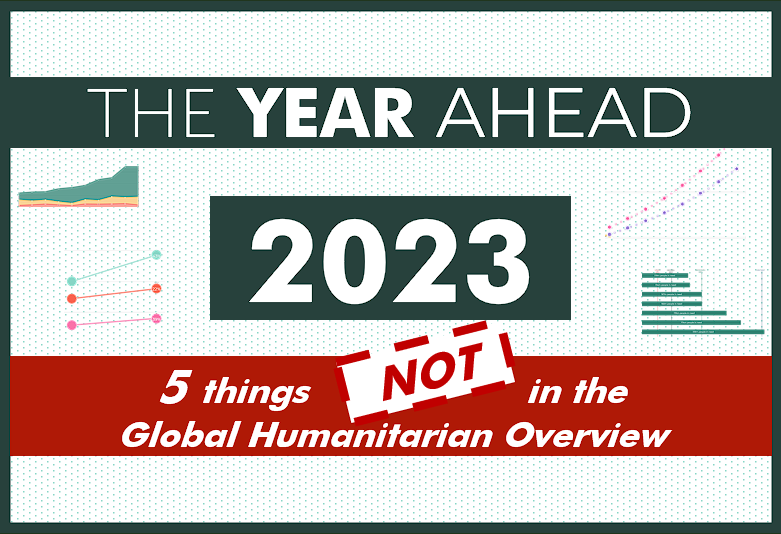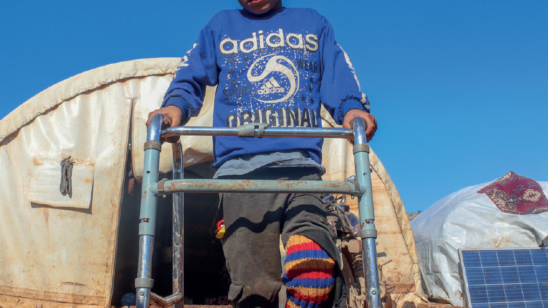
The Year Ahead 2023: 5 things not in the ‘GHO’9 min read
Another year and another Global Humanitarian Overview (GHO) is published. The 2023 abridged version (only 19 pages this year!) sets out the funding required, and the number of people in need for the year ahead.
But sometimes the most fascinating things to look at are those that are out of sight. We’ve picked out 5 trends that are crucial to keep in mind when you read the GHO.
Affected populations will need $100bn per year by 2027
In one of our most read stories this year, we looked at why the sector needs so much money. One of the things we found, looking at the past fifteen years of data, is that there is an annual growth rate of around 13%. We said that – based on this trend and the funding required at the time – that the sector would need $100bn by 2029 (that’s the purple dotted line below).
But we now think the sector will reach this milestone by 2027. This is based on two things. Firstly, the sector rarely only needs what it says it needs in the GHO. There are things that we don’t anticipate, such as the war in Ukraine, or COVID-19. Secondly, if we look at the annual growth rate of “what we need” in more recent years (2020-2023), it is more like 15%.
Take these two things, code them into assumptions, extrapolate out the trend, and we now get 2027 as the new date (the pink dotted line).
This seems wild. But then consider that we only needed $9bn in 2012, rising to $25bn in 2018, and suddenly the trend doesn’t seem so unrealistic or unthinkable.
On the contrary, it needs to be thinkable. The sector is in huge need of a rethink when it comes to either increasing financing, reducing needs, or both. The ticking time bomb of $100bn needed each year by 2027 is not far away. $100bn per year is surely unmanageable for a sector that this year raised ‘only’ $25bn according to FTS.
The sector could need $61bn in 2023, not the $51.5bn that the GHO claims
The Global Humanitarian Overview is a snapshot. It is what we think, in late November 2022, the sector will need in 2023. But snapshots only really represent that moment in time when the camera takes the photo.
Historical precedent shows us that the GHO often underestimates what is actually required in that year. For example, last year’s GHO said that $41.3bn was needed – in reality we needed $10.4bn more than what was in the GHO.
In 8 out of the last 10 GHO’s, the sector has actually needed more than what was initally stated. Reality doesn’t stop between yearly GHOs. During the year, we may need more money for contexts in the humanitarian architecture (think Afghanistan 2021), or there may be new responses we need to set-up (think the 2022 Ukraine refugee response)
So whilst the GHO claims the sector will need $51.6bn, it’s likely to be more. On average, across the last 10 GHOs, it has underestimated the actual amount by around 18% (ranges from -5% to 51%).
If we assume an underestimate of 18%, then the sector may need $61bn this year.
This is of course highly speculative. But we believe that speculation in this instance is not a bad thing. We should be able to look ahead with the facts that we know now (as per the GHO), but also prepare for what is likely – that humanitarian needs and funding required will grow throughout the course of the year.
Large-scale responses now dominate the funding ask
‘Twas ever thus that contexts that need more money dominate the funding ask. A decade ago, large value appeals (greater than $1bn) made up 50% of the funding ask, and now they make up 75% of the funding ask.
But whilst low (less than $500m) and medium value appeals make up a similar amount as they did 10 years ago (up from a combined $9.1bn to $12.8bn), large value appeals have ballooned.
A decade ago, large-scale responses needed $8.9bn. They now need $38.8bn for 2023. There are 13 contexts in this bucket, with the regional Syria response ($5.4bn), Afghanistan ($4.6bn), Syria ($4.4bn), Yemen ($4.3bn), Ukraine ($3.9bn), and Ethiopia ($3.5bn) all needing huge amounts.
However, there are 25 responses in the low- and medium-value category. The risk here is that large appeals crowd out smaller appeals. Smaller appeals may find it harder to raise money due to the sheer amount needed for the large-scale responses (we’ll look into the concept of crowding out in a future story).
As an example, anecdotally, last year many of us in the sector have seen or heard stories of funding diverted from smaller and lesser-prioritised crises, and towards Ukraine.
An affected population the size of the USA is ‘in need’
According to the GHO, 339 million people are in need of humanitarian assistance in 2023 – that’s the ‘People in Need’ number, or PIN.
It’s worth seeing this in the historical context. This is a doubling of those in need in only just three years. This is extraordinary. In the previous three year period (2017-2020), the PIN did increase, but not by this rate.
Now the ‘humanitarian population’ worldwide is 8x the population of Sudan, 4x the population of Germany, 2x the population of Bangladesh, and around the size of the USA population.
Yet, what is needed to meet humanitarian needs ($51.6bn) is a fraction of the USA GDP ($22,996bn) – to be precise: 0.2%. So whilst the humanitarian and USA population is around the same in size, humanitarian actors need only 1/500th the size of the US economy to meet humanitarian needs – and it’s highly unlikely that humanitarians will receive even this amount.
Not a uniform rise in PIN across contexts
The number of people in need globally has shot up, and this large increase is reflected in quite a number of contexts.
Five contexts in Southern and Eastern Africa see large increases in PIN, albeit for different reasons. The Kenya Flash Appeal has a new PIN 51% higher than this year, due in large part to droughts and food insecurity. Mozambique‘s PIN is 30% higher with the root cause being the continued impact of the Cabo Delgado conflict.
An extra 8.6m people are in need in Ethiopia due to the drought and the ongoing conflict. The regional South Sudan and Horn of Africa plans also had uplifts in the PIN.
Elsewhere, two plans in Asia also had large uplifts in the PIN. Over 2 million more people are in need in Myanmar due to the worsening conflict, which is increasing Protection and Food Security needs, amongst others. A similar amount are additionally in need in countries bordering Afghanistan, where there is expected to be a steady outflow of people in 2023 and host communities need to continue to be supported.
The number of people in need in Guatemala has also increased to 5m, driven by overlapping crises: the impact of Hurricanes Eta and Iota has been compounded by food insecurity, acute malnutrition and human mobility.
At the same time, there are a number of contexts that have seen a reduction of those in need. Despite the GHO narrative saying that in El Salvador “forecasts indicate a continuation of or an increase in needs”, the PIN has actually decreased – go figure!
The regional Ukraine refugee response also sees a reduction in the PIN by around 1m. Similarly, the reason isn’t particularly clear from the narrative. It could be an increase in returnees, as it is noted that “over 80 per cent of refugees do not plan to return to Ukraine in the near future”. But the reason behind a reduction of 1m, or 19%, should be spelt out more clearly.
The regional Syria response has reduced the PIN by around 4m, driven in large part by a reduction of the number in the host community who are ‘in need’. Again, you wouldn’t know it by looking at the narrative which says, “socioeconomic conditions among refugees and host communities are likely to deteriorate further, increasing poverty rates and tension incidents in the host countries”.
Yet there are two contexts with a bit more clarity.
Madagascar has reduced its PIN from 3.3m to 1.6m which is, as the GHO acknowledges, due to the fact that, “food insecurity and malnutrition improved in the Grand Sud, and no district has been in Emergency phase (IPC 4) since May 2022.”
Burundi does at least acknowledge the reduction in PIN: “In 2023, about 1.5 million people will need humanitarian assistance, a 17 per cent decrease compared to 2022 (1.8 million people)”. Bravo. But the reasons are less clear beyond a vague “relative improvement” in the humanitarian situation.
What the GHO doesn’t tell us, and what it should
1 – We need to look forward a bit more. $100bn by 2027 is a deafening clarion call to action. How will the system adjust to these demands?
2 – The GHO doesn’t tell us what will happen unexpectedly during the year, which is fair enough. But it should tell us to expect the unexpected, which in this sector is an occupational necessity. Funding requirements will very likely increase during the year. $51.5bn is a low baseline, not a hard ceiling.
3 – Larger plans make up the bulk of the funding ask and dominate (illustrated here). But is the inverse also true? Smaller plans risk getting overlooked.
4 – The PIN has hit a new high. But in a global context the PIN and funding requirement taken together are staggering. Those in humanitarian need are around the same number as the USA population, but just 0.2% of the value of the USA economy would meet their needs. Putting these huge numbers in a wider context can help us understand them more. $51.5bn is a big number, until you consider that $22,996bn (USA GDP) is just a tad bigger.
5 – The numbers don’t always match the narratives. It is understandable that needs are framed as “alarming”, or that conditions may “deteriorate”, but how can we match this with reductions in the PIN where this occurs? Setting out the reasons why there has been a fall in the PIN does not undermine a strong case for advocating for the needs of those that remain in the PIN.
Methodology and Sources
Methodology of ‘reaching $100bn’, assumption #1: estimating the actual funding requirement inclusive of new requirements that come through the year. For the previous projection, the requirement at the time of publishing was $46.7bn, and for the new projection we assume it will be 18.16% higher than published when we consider how previous years unfolded.
Methodology of ‘reaching $100bn’, assumption #2: the annual growth rate of the funding requirement. For the previous projection, we assume the annual growth rate is the average of the five-year CAGR of the last 15 years, 13.16%. For the new projection, we assume the growth rate is the average of the five-year CAGR of the last 4 years (i.e. since COVID-19), 15.04%.
Source of actual funding requirements (in other words, updated after the GHO is published): OCHA’s Financial Tracking Service.
Source of original funding requirements for the year ahead and 2023 PIN: Overview of the 2013 Consolidated Appeals, Global Humanitarian Overview 2014, 2015, 2016, 2017, 2018, 2019, 2020, 2021, 2022, and 2023.
Source of 2022 PIN: Hum-Insight extracted 7th November 2022.
Source of USA GDP figure: from Trading Economics page on the United States GDP. Data extracted on 6th December 2022.

